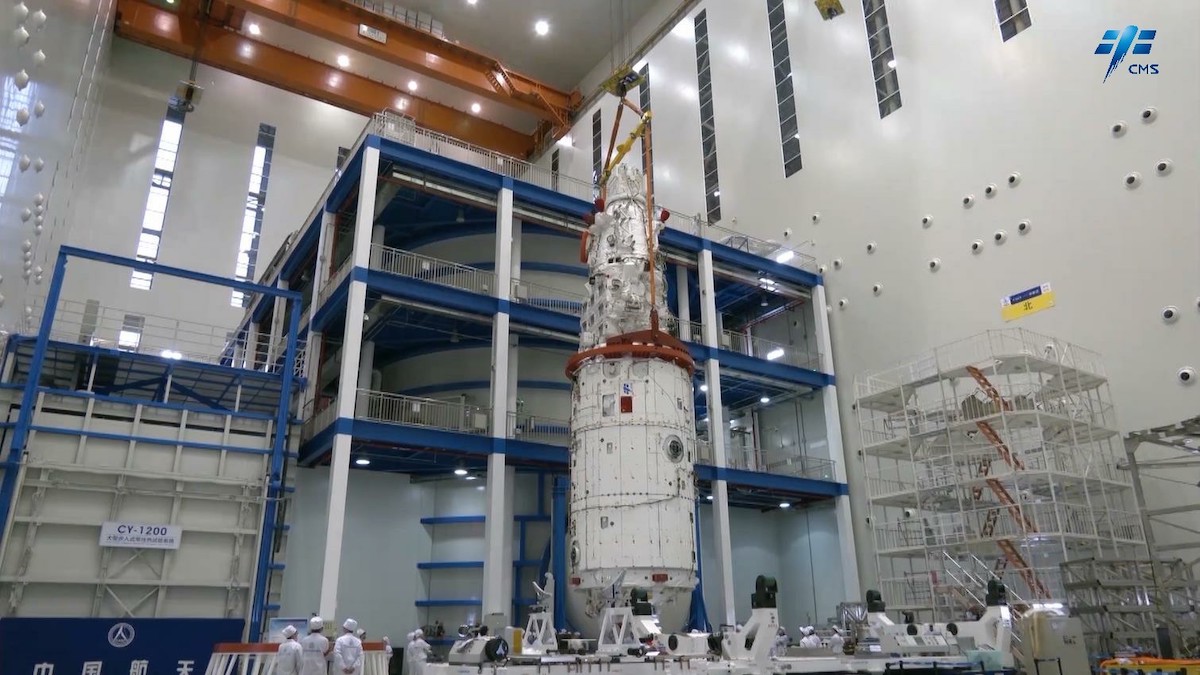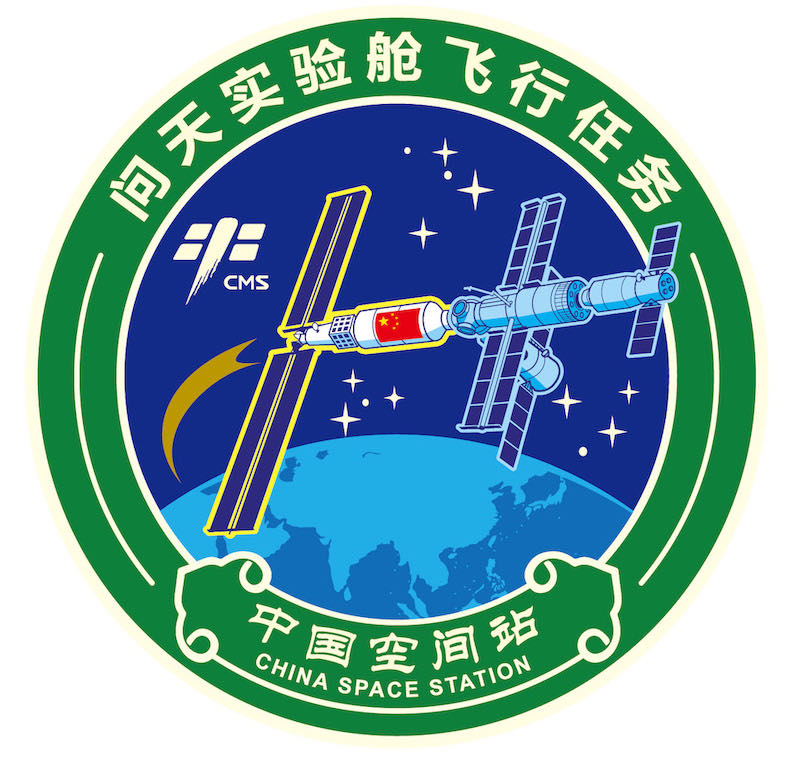EDITOR’S NOTE: The English-language live broadcast of the Wentian module’s launch is embedded on this page. The video feed comes from China’s CGTN television network.
China’s heavy-lift Long March 5B rocket was fueled for launch early Sunday with the second major element of the Chinese Tiangong space station, adding a new working compartment for the three astronauts living on the orbiting research lab.
The Wentian lab module is buttoned up for launch on the Long March 5B rocket at approximately 2:17 a.m. EDT (0617 GMT) Sunday from the Wenchang space center on Hainan Island, China’s southernmost province.
The launch will mark the eighth flight of a Long March 5 rocket, the most powerful launcher in China’s inventory. It will be the third flight of the Long March 5B configuration, which flies without an upper stage and is tailored to haul heavy payloads into low Earth orbit. The Long March 5B launcher’s lift capability to low Earth orbit is around 55,000 pounds, or 25 metric tons.
The 176-foot-tall (53.7-meter) Long March 5B rocket was loaded with kerosene fuel for its strap-on boosters and cryogenic liquid hydrogen fuel for its core stage in the final hours before liftoff Sunday. The boosters and core stage will also consume super-cold liquid oxygen in combination with the liquid fuel to power the Long March 5B off its seaside launch pad at Wenchang.
Gantry arms on the Long March 5B’s 300-foot-tall (92-meter) launch pad tower will open in the final phase of the countdown, clearing the way for the heavy-lifter to take off from Wenchang and head east over the South China Sea.

In the final seconds before liftoff, sparkers will fire under the Long March 5B’s core stage to burn off any hydrogen gas that accumulated during the countdown. Then the core stage’s twin YF-77 hydrogen-fueled engines will flash to life, followed moments later by ignition of eight kerosene-fed YF-100 engines ignited on the rocket’s four strap-on boosters
The ten engines will push the Long March 5B rocket into the sky with 2.4 million pounds of thrust.
The four boosters will cut off and jettison about three minutes into the mission, and the core stage will consume all its propellant about eight minutes after liftoff, before releasing the Wentian lab module for the rest of the journey to the Tiangong space station.
The Wentian module encapsulated for launch inside the Long March 5B’s 67-foot-long, 17-foot-wide (20.5-by-5.2 meter) payload fairing carries a robotic arm and mounting posts to host science instruments and unpressurized experiments in the vacuum of space.
There are accommodations for life science and biological research racks inside the module’s pressurized volume, and the new module will add an airlock to support spacewalks outside the Tiangong space station.

The Wentian module, with a launch weight near 50,000 pounds (23 metric tons), will dock with the Tianhe core module on China’s Tiangong station in low Earth orbit. Chinese astronauts Chen Dong, Liu Yang, and Cai Xuzhe living on the Tiangong complex will monitor Wentian’s arrival, then become the first crew members to float into the station’s new module.
The massive Wentian module will unfurl solar panels to a span of about 180 feet (55 meters) tip-to-tip to produce its own electricity.
The launch of the Wentian science lab will add the second of three large pressurized modules needed to complete the initial construction of the Tiangong station. The Tianhe core module launched on a Long March 5B rocket in April 2021, and Chinese ground teams are preparing the Mengtian module for launch on a Long March 5B rocket in October.
The Wentian module carries a small robotic arm designed for more precise movements than the larger arm positioned outside the Tianhe core module. Wentian’s arm will primarily be used to transfer experiments and other hardware outside the station.
Wentian, which means “quest for the heavens,” will initially dock with an axial port on the Tianhe module, a docking mechanism that was recently cleared by the departure of a no-longer-needed Tianzhou cargo ship. Tianhe’s mechanical arm will move the module to its final position on the side of the space station’s core section.
The Mengtian module scheduled for launch later this year will arrive at the Tiangong space station in a similar way. Once Wentian and Mengtian are in their final positions, the Chinese station will have a distinctive “T” shape with its three main pressurized elements.
The crew on the complex will stage two or three spacewalks from the Wentian module in the next few months.
“The Wentian experimental cabin is mainly for space life science research, equipped with experimental cabinets such as life ecology, biotechnology, and variable gravity science,” said Lin Xiqiang, deputy director of the China Manned Space Agency, in a press briefing last month.
Wentian’s experiments will support research into genetics, aging, organs, tissues, and cells. The variable gravity experiment rack can generate accelerations between a hundredth the pull of Earth’s gravity up to 2g, supporting comparative studies under different gravity conditions, according to the China Manned Space Agency.

The design of the Long March 5B rocket used to launch the Wentian module means the launcher’s core stage is expected to enter orbit before releasing its payload.
The core stages on the previous Long March 5B missions in 2020 and 2021 re-entered the atmosphere about one-to-two weeks after launch. The Long March 5B’s core stage measures about 100 feet (30 meters) long and has an empty mass of about 23.8 tons (21.6 metric tons), making it one of the largest and most massive human-made objects to ever re-enter the atmosphere in an uncontrolled manner.
A similar uncontrolled re-entry is expected for the Long March 5B core stage after the launch of the Wentian space station module Sunday.
After the most recent Long March 5B launch and re-entry last year, NASA Administrator Bill Nelson said China was “failing to meet responsible standards regarding their space debris.”
“Spacefaring nations must minimize the risks to people and property on Earth of re-entries of space objects and maximize transparency regarding those operations,” Nelson said in a statement last year.
Wang Wenbin, a spokesperson for the Chinese Foreign Ministry, said in a press conference last year that it is “common practice” for upper stages of rockets to burn up while re-entering the atmosphere. He incorrectly referred to the Long March 5B rocket body as an upper stage, and said that “most of its parts will burn up upon re-entry, making the likelihood of damage to aviation or ground facilities and activities extremely low.”
But no other launcher in the world leaves such a massive component in orbit to fall back to Earth. Dead satellites and old rocket stages regularly re-enter the atmosphere, but re-entering objects with masses of more than a few tons are rare.
Larger booster and core stages used on other rockets typically fall back to Earth without reaching orbit, usually in areas downrange from the launch site that are clear of people.
Like most space junk that comes back into the atmosphere, much of the Long March 5B rocket burns up as temperatures reach thousands of degrees during re-entry. But some debris could reach Earth’s surface intact.
The risk of any of the rocket debris harming someone or damaging property is low, with objects most likely to fall into the ocean or in unpopulated areas. But the uncontrolled re-entry of the first Long March 5B core stage in 2020 spread debris over the Ivory Coast. The Long March 5B re-entry last year occurred over the Indian Ocean.
The Chinese space station orbits about 236 miles (380 kilometers) above Earth, at an inclination of 41.5 degrees to the equator. The orbit means the spent Long March 5B core stage could come down anywhere between 41.5 degrees north and south latitude.
Email the author.
Follow Stephen Clark on Twitter: @StephenClark1.
from Spaceflight Now https://ift.tt/Wlv0zTw
via World Space Info







0 comments:
Post a Comment